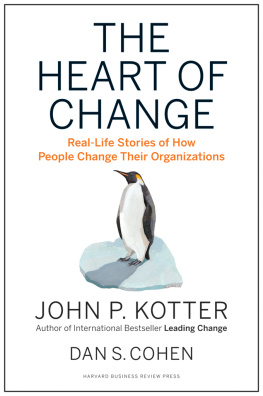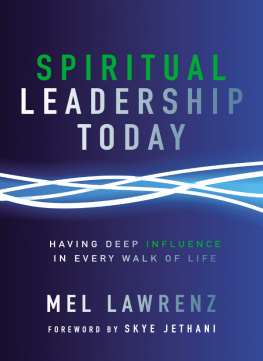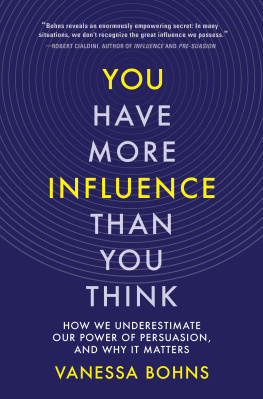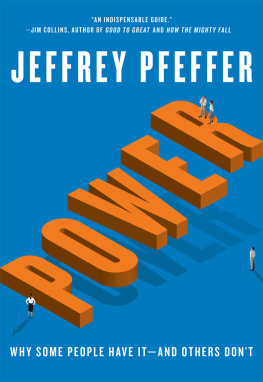 ACKNOWLEDGMENTS
ACKNOWLEDGMENTS(With a Brief Description of the History of the Book)
THIS book has roots in seven different research and course development projects conducted during the 1970s and 1980s at Harvard Business School. These projects involved dozens of individuals, many of whom have made important contributions to this book.
The very first inquiry, launched in 1971 and completed in 1974, focused on mayors in twenty large U.S. cities. especially regarding the question of how situationally specific effective ways of organizing are. But in addition, the project helped launch a new line of inquiry, one that focused on power, influence, and leadership in complex settings.
It is almost incredible how complex these mayoral jobs were. Limited resources, conflicting demands from various constituencies, an unending number of distractive power struggles, and many other factors made achieving anything difficult. Yet in a few casesnot manythe mayors were able to orchestrate achievements of which both they and the residents of their cities were very proud. To understand all this, we found that one needed above all to appreciate the issue of powerits development and its use. Put succinctly, the more effective mayors were more successful in developing and using power to lead a large and complex network of people and groups. In contradiction to the popular stereotype, the strong mayors were not the ones who became involved in scandals, graft, and corruption; it was the weak mayors who were vulnerable and often desperate.
In 1974, a project was designed to follow up the mayors study. A group of twenty-six organizations ultimately participated in this inquiry, organizations of various sizes and ages in retailing, banking, consulting, advertising, electronics manufacturing, health care, education, heavy-equipment manufacturing, insurance, communications, food, clothing, the arts, government, power generation, investment management, and consumer products manufacturing. In each case, the top ten to twelve officials were interviewed and as much documentation on the organization as practical was obtained. Ultimately, this information was analyzed from two perspectives. The first focused on questions of how these organizations evolved, developed, and changed over time.in my mind was gone about the relevance to the private and nonprofit sectors of much I had seen in the public sector.
The public-private distinction is both useful and distracting. It is useful in that, at the extremes, what one finds in the public sectorno bottom line profitability standard, for examplecan be very different from what one finds in the private sector. It is distracting because it downplays similarities, and there can be many similarities. Although the problems caused by conflicting demands, resource constraints, and power struggles are usually more severe in the public sector, they also clearly exist in private and nonprofit organizations. Furthermore, I found that the general solution to coping with such problems was the same, too. Wanting very much to make a difference, although a necessary condition, was far from sufficient. Both studies suggested that one also needed a strong sensitivity to the complex social milieu in which one operated, as well as skill at the development and use of power and influence.
During 1975, while still working on the twenty-six-organizations study, I took over our required MBA course entitled Organizational Problems. At the time, this course was not viewed very favorably by either students or faculty. Jay Lorsch, then the head of the Organizational Behavior area at Harvard, encouraged us to try something new. Over the next three years, a group of people, including Len Schlesinger, Vijay Sathe, Mike Beer, Roosevelt Thomas, and Victor Faux, began a case development effort in a number of well-known U.S. companies. Previous work by Lorsch (and Lawrence) helped guide the course development effort in at least one very important way. It sensitized us to two important dimensions that create complexity in the social milieu associated with modern organizations: (1) diversity (of beliefs, goals, values, skills, etc., among the people involved) and (2) interdependence (among those people). By focusing more on those dimensions, and by including more issues explicitly associated with power, influence, and leadership, the managerial behavior we were documenting became more understandable. Actions that were difficult to explain or interpret, especially those
Running in parallel with these first three projects was another line of inquiry which did not focus on questions of power, influence, and leadership, but instead on the topic of career development in managerial and professional jobs. This career development work began for me in 1969, under the supervision of Ed Schein at MIT.
Two themes emerged early in this work. The first relates to job/person fit. Whenever the people we studied moved into situations that did not fit their skills, interests, expectations, needs, and experiences to some minimum degree, problems arose, regardless of how talented the individuals were in a general sense, and regardless of how much they really wanted to succeed, be effective, or make a difference. The second theme relates to career stagesto the fact that some of the issues, problems, and challenges people face in their work lives tend to be predictably different at different stages in their careers, and that a sensitivity to these stage-specific issues can help one deal with those issues more effectively.
It was not until the late 1970s that these two streams of researchone on career development, the other on leadership and powerclearly began to merge. This first occurred in what was called the General Managers Research Project. These fifteen executives ranged in age from thirty-seven to sixty-two and, on average, were paid a yearly salary of $150,000 in 1978 dollars. Unlike previous work, this project used, in addition to interviews, questionnaires, and documents, a considerable amount of observation. That is, each of these executives was actually observed in action over a period of time.
Themes associated with the complexity of the social milieu inside modern organizations, with power and the importance of influence skills, and with job-person fit, were all confirmed and extended in this study. Furthermore, the project clearly showed us that to understand why these successful managers were able to behave as they did, it was essential to understand their career and early-life histories. That is, to account for similarities and differences in their leadership styles, their use of power, and their ability to influence others, one had to look at similarities and differences in their career and childhood development.
The seventh and final project upon which this book is built was begun in 1978. Based on the previous work, I decided to develop a new MBA course called Power and Influence. Over the following four years, a few dozen new field-based cases were developed, many with assistance from John Stengrevics; and this book was begun.
Of the additional insights developed in this final project, four are particularly important. First of all, in thinking about managing the social milieu surrounding a job, I found it is useful to distinguish relationships with bosses from those with peers or outsiders from those with subordinates.in this book to MBAs and to practicing managers. Over time, it became clearer and clearer that a large percentage of these people were surprisingly nave about this subject matter. A smaller group embraced equally inaccurate cynical beliefs. In both cases, the distorting lenses they wore created problems both for them and for those with whom they interacted. The fourth and final insight was inspired by my rereading some of Al Chandlers work on the historical evolution of modern management and the modern business organization. This led to an examination of how managerial, professional, and technical jobs have been changing with respect to issues of power and leadership over the last century, and especially in the last three or four decades. This exploration eventually led to the central thesis of the book.












